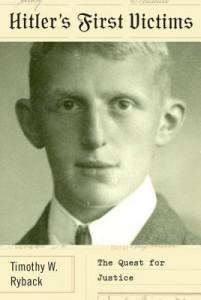Title: Hitler’s First Victims: The Quest for Justice
Author: Timothy W. Ryback
ISBN: 9780385352918
No. of Pages: 288
Genre: Nonfiction
Origins: Knopf Doubleday Publishing Group
Release Date: 21 October 2014
Bottom Line: Fascinating look at a quiet hero
 Synopsis:
Synopsis:
“The remarkable story of Josef Hartinger, the German prosecutor who risked everything to bring to justice the first killers of the Holocaust and whose efforts would play a key role in the Nuremberg tribunal.
Before Germany was engulfed by Nazi dictatorship, it was a constitutional republic. And just before Dachau Concentration Camp became a site of Nazi genocide, it was a state detention center for political prisoners, subject to police authority and due process. The camp began its irrevocable transformation from one to the other following the execution of four Jewish detainees in the spring of 1933. Timothy W. Ryback’s gripping and poignant historical narrative focuses on those first victims of the Holocaust and the investigation that followed, as Hartinger sought to expose these earliest cases of state-condoned atrocity.
In documenting the circumstances surrounding these first murders and Hartinger’s unrelenting pursuit of the SS perpetrators, Ryback indelibly evokes a society on the brink—one in which civil liberties are sacrificed to national security, in which citizens increasingly turn a blind eye to injustice, in which the bedrock of judicial accountability chillingly dissolves into the martial caprice of the Third Reich.
We see Hartinger, holding on to his unassailable sense of justice, doggedly resisting the rising dominance of Nazism. His efforts were only a temporary roadblock to the Nazis, but Ryback makes clear that Hartinger struck a lasting blow for justice. The forensic evidence and testimony gathered by Hartinger provided crucial evidence in the postwar trials.
Hitler’s First Victims exposes the chaos and fragility of the Nazis’ early grip on power and dramatically suggests how different history could have been had other Germans followed Hartinger’s example of personal courage in that time of collective human failure.”
Thoughts: There are many what-ifs in history, but few are quite so compelling as those that surround Hitler’s rise to power and slow strangulation of democracy in Germany in the 1930s. There were indeed several opportunities to have stopped Hitler or at least thwarted his plans more thoroughly than occurred. Timothy Ryback looks to shine the spotlight on one of the heroes who did stand up to fight against the increasing stranglehold the Nazis held on German political and police systems. Hitler’s First Victims shows that while he may not have been successful in 1933, his efforts had a profound effect on the post-war trials.
However, this is not a Holocaust story; the 1930s were only the beginnings of the Nazi regime, and what would be known as the Holocaust was still only Hitler’s dream. At that point in time, there were still states’ rights, state police systems, local judicial systems, and a president who had greater authority than Hitler. The Communist party was a major threat to Germany’s fledgling democracy, and political upheaval abounded. Hitler’s First Victims shows how Germany dealt with such upheaval, invoking the idea of protective custody to incarcerate hundreds of political detainees without due process or even any formal charges.
Hitler’s First Victims is as much the evolution of Dachau from an abandoned manufacturing site to the concentration camp it became during the war as it is about the lone prosecutor who tried to stymie the Nazi rule. Named after the nearest train station, Dachau started out its life under the rule of the state police. However, there was a constant push by the Nazis to control all police proceedings, including detention and punishment. As the first of its kind, Dachau and its inhabitants became the victims of a much greater power struggle and one that would have horrendous consequences for millions.
The story Mr. Ryback has to tell in Hitler’s First Victims is fascinating and horrifying. He withholds nothing, and the Nazi atrocities he details are as repulsive and barbaric as one would imagine. What occurred in Dachau six years before the beginning of the war and eight years before the Final Solution went into operation will boggle a reader’s mind and cause one to question the general goodness of humans. That there were people who were willing to risk everything to right the wrongs they saw provides a much-needed sense of relief that all humanity was not lost.
Hitler’s First Victims is meticulously researched and highly respectful of the victims described and the man behind the argument of collective guilt. Each person mentioned gets equal treatment in the form of a detailed background and the path that led him to Dachau. It is at times an intense read, as there is an abundance of information crammed into a fairly short narrative. Mr. Ryback not only details each of the men, he explains the political structure in Germany, the legal system, and history as it pertained to and influenced German citizens before, during, and after 1933. With detailed notes and appendices, one can easily verify Mr. Ryback’s research and use his sources for his or her own research. Herr Hartinger’s story is an important one to tell, and his diligent quest for the truth is a vital reminder to all that while it takes courage to do the right thing, we as humans have a duty to do so. If more people had done so in 1933, the world would be a very different place indeed.
